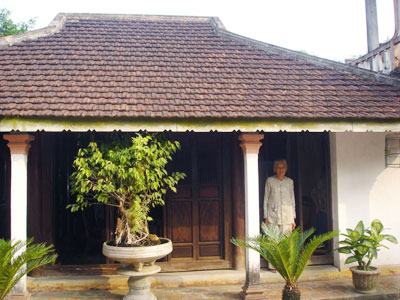Nestled along the romantic O Lau River in north-central Quang Tri Province, the 500-year-old village of Hoi Ky remains a national treasure of Vietnamese heritage.
 |
| The antique house built in T-shape is 121 years old. |
The small community, situated in Hai Chanh commune, was once home to 60 households along the riverbank. Courtyards shaded by banyan trees created a nostalgia for residents, reminding them of a time when their ancestors founded the new land.
But as the centuries passed, the little village was subjected to the ravages of war and little was done to preserve its unique character. While it continued to stand, signs of dilapidation increased. Later, as the country began to recover from the devastation of wartimes, new businesses moved into the area, looking to raze much of what was left of the old village.
Today, the very existence of the ancient homes is in jeopardy and local officials say that more preservation efforts are urgently needed to save this precious part of Vietnam’s history.
Ornate heritage homes
The antique house of local resident Duong Van Khanh Manh, called Tich Khanh Duong, was built in 1889 during the reign of King Thanh Thai. The home is now 121 years old and Mr. Manh is part of the fourth generation to live in the house and carry on the tradition of ancestor worship.
The house has a width of 12.3 meters, a length of 9.5 meters, and is divided into three sections built in T- shape. A total of 18 doors are also divided into groups of three to create balance in the home. In addition, there are four alternating tiled roofs and nine graded ones comprising over 10 thousand tiles. The house is supported by 48 pillars made of jack fruit wood (forest jack), with each pillar measuring 30cm in diameter.
In the center of the home is an altar, complete with a horizontal lacquered board inscribed with the words "Tich Khanh Duong" in Chinese characters. Antique fixtures such as bronze urns, incense bowls, candlesticks and flower vases adorn the worshipping area, and on either side of the altar there are four scrolls of Han characters intended to educate future generations.
Roughly translated, the scrolls convey a message of hope for descendants to live a life of piety, develop good virtues and be worthy of carrying on the family name into eternity.
Nearby is the house of Madam Duong Thi Huong, called Duc Luu Quang. The home’s name means “the passing on of virtues,” and was built more recently in 1931. It covers 60 square meters and also contains a central alter area.
The worshipping area is divided into two, and in the middle is an inscribed couplet written in Chinese characters. It translates roughly as: Enjoy blessings from ancestors; four generations of descendants will prosper; the clan will achieve eternal glory through blessings.
Also located in the home is a horizontal lacquered board inscribed with the words “Tu dai dong duong” (four generations under one roof). According to this ancient concept, a house with four successive generations living in it, is a blessed one.
Urgent preservation efforts needed
Today, the ancient village of Hoi Ky is at risk of being completely destroyed in the name of modernization and urban development.
Mr. Cap Xuan Ta, head of the local Culture and Information Department, said, "Only the village of Hoi Ky still contains many antique houses of high cultural value. Sadly, most of them have not been repaired and staff have not received proper training on how to preserve them optimally. Hence, much of the cultural architectures has been [negatively] affected."
Across the O Lau river, meanwhile, the ancient village of Phuoc Tich in Thua Thien-Hue Province has already been recognized by the State as a National Heritage site. Each year, Phuoc Tich attracts hundreds of tourists who come to visit and study the village, contributing to the development of tourism in the area.
Many people believe that if the village of Hoi Ky were properly assessed, restored and invested in, the village could not only become an ideal tourism stop, but also regain its former glory as an important piece of Vietnamese history.

Leave your comment on this story